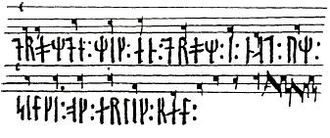Drømtmig en drøm i nat
Drøchte mig en drøm i nat ( Dreamed a dream in the night ) is the title of the oldest known Danish folk tune with notes. The text is written in Nordic runes in medieval Danish and is preserved today in the Codex Runicus , where it forms a final note. The Codex Runicus is the oldest preserved copy of the Scanian Law ( Skånske lov ). The melody isnotatedin an early form of musical notation with two individual staves .
song lyrics
The medieval text of the song reads:
Drømde mik en drøm i nat um
silki ok ærlik pæl
There are different interpretations of the text as the meaning of the words silki and ærlik pæl is unclear. Traditionally, most of the interpretations are variants of the readings:
"I had a dream last night of silk and fine fur."
"I dreamed a dream of silk and expensive cloth last night."
These interpretations take the meaning of the word silki as 'silk'. It can be compared to the medieval song Palle Boosons Visa , which also speaks of "silk and fine fur": Han kläder sig i silke, så ock i ädel päll ...
This interpretation has been challenged because it ignores the context of the document. The Codex Runicus is a legal code that ends with a text of marginalia . Since the song appears to have come from the same hand that completed the main body of the manuscript, it would seem more appropriate if the lyrics of the songs were related to the content of the document. One would expect a text about law and order rather than luxury.
Alternative interpretations that better fit this understanding of the song context are:
"I dreamed a dream of justice and fairness last night"
"I dreamed a dream of equality and honesty last night"
The word silki could be seen as related to the Old Norse word slik ( lika "equality", likadan "same as"). Likewise, ærlik pæl could be ' honest measure', since päla and the related forms pæl and pel are old words for “measure”, related to German level . Ærlik is also used on the first page of the Codex Runicus , where it is translated as "honest" ( ærlig in modern Danish).
melody
While there is agreement about the notes of the melody (other than the ligatures ), a variety of rhythmic interpretations are possible.
Tobias Norlind believed the melody was an early version of Staffansvisan , a song about St. Stephen , known in several versions and used in the annual rites. However, Norlind did not try to interpret the rhythmic structure of the song.
For a few years the melody was the pause signal at Danmarks Radio .
In the following version, the first half of the melody is interpreted as a trochee :

Another interpretation, based on rhythmic structures more commonly found in older traditional music, shows us a standard dance song of four plus four bars :


Web links
- Den Arnamagnæanske Samling ( Memento of February 4, 2008 in the Internet Archive )
- Drønte mig en drøm i nat (8-part movement by Brian Stenger Poulsen) : Sheet music and audio files in the International Music Score Library Project
Individual evidence
- ↑ Codex Runicus . In: Kommissions for det Arnamagnæanske Legat (ed.): Det Arnamagnæanske Haandskrift No 28, 8vo . København 1877.
- ↑ Oscar Bandle (Ed.): The Nordic Languages. An International Handbook of the History of the North Germanic Languages. Vol. 2 (= Handbooks for Linguistics and Communication Studies, Vol. 22.2), de Gruyter, Berlin / New York 2005, ISBN 3-11-017149-X , p. 1077.
- ↑ Sometimes also transcribed as Drømdæ mik æn drøm i nat ; see: Rune Brandt Larsen: Drønte mig en drøm i nat . (PDF).
- ^ Adolf Iwar Arwidsson: Svenska Fornsånger, första delen . P. 199 (Swedish).
- ↑ Åke Persson, Johannes Holmqvist: Våra äldsta melodier - Codex Runicus - del 2. In: Runtenom 2003–4, p. 6 ( digitized version ( memento of April 2, 2012 in the Internet Archive )).
- ↑ Corpus iuris Sueo-Gotorum antiqui: Samling af Sweriges gamla lagar. Pp. 288, 294, 314, 319 ( limited preview in Google Book search).
- ↑ For further interpretations see FolkWiki
- ↑ Åke Persson: Våra äldsta melodier - Codex Runicus. In: Runtenom. 2000–1, p. 7 ( digitized version ( memento of April 2, 2012 in the Internet Archive )) (Swedish).

